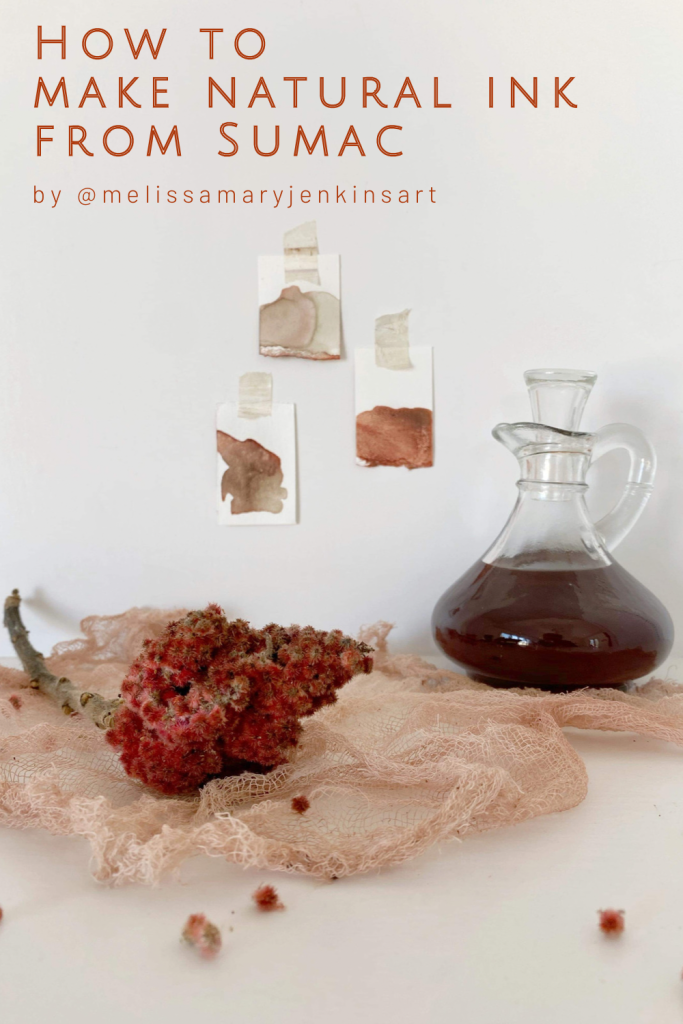
It is that time of year where the snow is melting and hints of green life are starting to appear, but plants that provide us with ink are in low supply. This is when the long-suffering Sumac can provide us with a pop of colour.

Sumac grows in abundance; the berries and leaves are high in tannins and they can be used for ink all year round. Tannins are a group of chemicals that are pale-yellow to light-brown that are found in plant cells, especially in leaves, bark and fruit. Tannins discourage fruit-eating animals from eating the fruit until the seeds are mature and ready for dispersal. As the fruit ripens, the tannin content lessens. The tannins in sumac berries and leaves help create durable, long lasting colours.
Sumac berries also store well. The berries can be harvested in the summer when they are ripe and then stored indefinitely in paper bags. Always remember to leave the area where you forage as untouched as possible and to leave ample berries behind, as Sumac serves primarily as a winter emergency food for wildlife.
A few notes about this recipe. Water or vinegar can be used as a base of this ink but I have used vinegar to help intensify the colour. Please refer to my previous blog post if you have questions about alum, gum arabic or how to preserve your ink https://melissamaryjenkins.com/2020/06/05/answering-your-questions-about-natural-inks/ .

Ingredients:
3 cups cleaning vinegar (vinegar intensifies the colour)
3 cups fresh sumac berries and leaves (use your hands to remove the berries from the stems)
2 tsp alum
1 tsp gum Arabic powder
1 clove
Materials: *keep these materials ONLY for making inks *
stainless steel or glass (these are nonreactive materials) pot, lid, bowl, jar, stirring spoon and fork
fine mesh strainer
cheese cloth (enough to line the strainer)
rubber gloves
glass jar with tight fitting lid
small funnel

Directions:
-simmer the berries in vinegar and alum, stirring as needed until you reach the desired colour (about ½ an hour) be sure to keep the
*ensure that you are in a well-ventilated area and keep a lid on the pot to avoid breathing in the fumes.
-turn off the heat and leave overnight (not necessary but may help form a darker color)
-line the strainer with cheesecloth and place over the bowl
-pour the berries and ink into the fine mesh strainer and allow the ink to drain
-using your rubber gloves, gather the cheese cloth around the berries and squeeze out any excess ink
-dispose of the strained sumac and wash out the cheesecloth
-place the filter in the lid of a glass jar and line the filter with the cheesecloth
-pour the ink into the filter (repeat if necessary to remove any little bits of plant matter)
-whisk in gum Arabic a little at a time with a fork until dissolved
*if it is not dissolving, heat the ink again but don’t bring to a boil*
-when cool, add in a clove
-make sure that there is no air space inside the bottle (to help prevent mold growth)
-secure the lid and refrigerate to help preserve
-shake before use
* the pink sumac ink dries to a brownish pink colour on watercolour paper and remains peachy/pink on natural fabrics/paper
NOTES
Alum acts a mordant
Gum Arabic thickens, helps with controlling ink flow, binds the ink to the paper and helps preserve
adding a Clove helps to prevents mold


